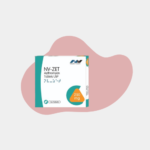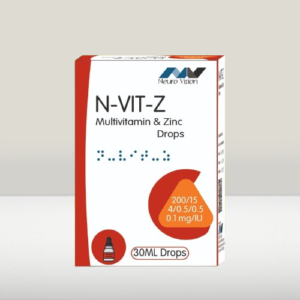Description
NV-ZET 500MG TABLETS
Azithromycin 500 mg – Further Detailed Explanation
1. Drug Overview: Azithromycin 500 mg is a macrolide antibiotic commonly prescribed to treat a wide range of bacterial infections. It works by inhibiting the production of proteins in bacteria, preventing them from growing and reproducing. This action makes it effective against several types of bacterial infections, especially those affecting the respiratory system, skin, and ears.
2. Drug Group: Azithromycin belongs to the macrolide class of antibiotics, alongside other drugs like erythromycin and clarithromycin. Macrolides are known for their ability to bind to the bacterial ribosome, specifically the 50S ribosomal subunit, thereby blocking bacterial protein synthesis. This results in the inhibition of bacterial growth and replication, rather than directly killing bacteria (which is why it’s considered bacteriostatic).
3. How Azithromycin Works:
Mechanism of Action: Azithromycin interferes with the protein synthesis of bacteria by binding to the 50S subunit of the bacterial ribosome. By doing this, it prevents the bacteria from producing proteins essential for their growth, repair, and reproduction. This ultimately halts the spread of infection.
Bacteriostatic Nature: Azithromycin is considered a bacteriostatic antibiotic, meaning it inhibits bacterial growth rather than killing bacteria outright. This allows the body’s immune system to destroy the bacteria more effectively.
4. Pharmacokinetics (What the Body Does to Azithromycin):
Absorption: Azithromycin is well absorbed when taken orally, with peak blood concentrations typically reached within 2-3 hours of ingestion. Its absorption is not significantly affected by food, but a large meal can slightly delay its peak absorption.
Distribution: Once absorbed, Azithromycin is widely distributed throughout the body, including high concentrations in tissues like the lungs, skin, middle ear, and tonsils—areas that are commonly affected by infections. This makes it particularly effective for treating respiratory and ear infections.
Metabolism: Azithromycin is minimally metabolized by the liver, meaning the drug doesn’t undergo extensive breakdown in the liver. This is significant because it helps maintain effective levels of the drug in the bloodstream without being rapidly eliminated.
Excretion: Azithromycin has an extended half-life of about 68 hours, which is longer than many other antibiotics. This allows it to continue working even after the treatment period has ended. The drug is primarily excreted through bile (produced by the liver) and only a small amount is excreted in urine.
5. Pharmacodynamics (What Azithromycin Does to Bacteria):
Bacteriostatic: Azithromycin works by stopping bacterial growth and reproduction, allowing the body’s immune system to fight off the infection. It does this by binding to the bacterial ribosome and blocking protein synthesis, which is essential for bacterial survival.
Broad-Spectrum Activity: Azithromycin is effective against many gram-positive and gram-negative bacteria, including common pathogens like Streptococcus pneumoniae (causing pneumonia), Haemophilus influenzae (causing respiratory infections), and Chlamydia trachomatis (causing chlamydia).
6. Key Uses (What It Treats): Azithromycin is prescribed for a range of bacterial infections, including:
Respiratory Tract Infections: It is commonly used to treat pneumonia, bronchitis, sinusitis, and pharyngitis (sore throat).
Ear Infections (Otitis Media): Azithromycin is particularly useful for treating middle ear infections, especially in children.
Skin and Soft Tissue Infections: It is effective in treating skin conditions like cellulitis and impetigo, as well as infections in soft tissues.
Sexually Transmitted Infections (STIs): Azithromycin is frequently used to treat chlamydia and gonorrhea, often in combination with other antibiotics.
Chronic Obstructive Pulmonary Disease (COPD): Azithromycin can be used to prevent flare-ups of COPD that are caused by bacterial infections.
7. Special Features:
Long Half-Life: Azithromycin’s long half-life of 68 hours means it can be taken once a day, and typically only requires a 5-day course of treatment. This is much shorter than many antibiotics, which require longer courses.
Excellent Tissue Penetration: Azithromycin is known for its ability to penetrate tissues efficiently. This is particularly beneficial for infections in areas like the lungs, sinuses, and ears.
8. Side Effects: While Azithromycin is generally well tolerated, it can cause side effects in some people:
Common Side Effects:
Gastrointestinal issues: Nausea, diarrhea, and abdominal pain are common, especially in the early stages of treatment.
Headaches and dizziness: Some patients may experience mild headaches or dizziness.
Serious Side Effects:
QT Prolongation: Azithromycin can lead to changes in the heart’s electrical activity, specifically QT interval prolongation, which can cause irregular heart rhythms. This is a concern for individuals with heart conditions or those taking medications that also affect heart rhythms.
Liver Damage: Although rare, Azithromycin can cause liver damage. Symptoms include yellowing of the skin and eyes (jaundice), dark urine, or severe abdominal pain.
Severe Allergic Reactions: Some individuals may experience an allergic reaction, including swelling of the lips, face, or throat, difficulty breathing, or a rash. These reactions require immediate medical attention.
9. Benefits:
Broad-Spectrum Activity: Azithromycin is effective against a variety of bacteria, making it suitable for treating many different types of infections.
Convenient Dosing: It is often prescribed for just a 5-day course, which improves patient adherence compared to antibiotics that require longer treatment periods.
Fewer Side Effects: Compared to other antibiotics, Azithromycin generally causes fewer gastrointestinal and allergic reactions.
10. Pregnancy Safety: Azithromycin is classified as FDA Category B. This means that animal studies have shown no harm to the fetus, and although there are no definitive human studies, it is generally considered safe for use during pregnancy when the benefits outweigh the risks. However, it’s important to consult with a healthcare provider before taking Azithromycin during pregnancy to ensure that it’s the right choice for both the mother and the baby.
11. Drug Interactions: Azithromycin can interact with other medications, including:
Antiarrhythmic drugs (drugs used to treat heart problems) and other medications that prolong the QT interval, as they can increase the risk of heart rhythm problems.
Antacids containing aluminum or magnesium may reduce the absorption of Azithromycin. It’s recommended to take them at least 2 hours apart.
—
Conclusion:
Azithromycin 500 mg is a highly effective, convenient, and broadly effective antibiotic used to treat many bacterial infections. Its long half-life, once-daily dosing, and short treatment course make it a preferred choice for treating respiratory, ear, skin, and sexually transmitted infections. Though generally well-tolerated, it can have side effects, especially related to gastrointestinal issues, liver function, and heart rhythm. It is classified as Category B for pregnancy, meaning it is generally considered safe but should be used under medical supervision. Always consult a healthcare provider before using Azithromycin to ensure it is the appropriate treatment.









Reviews
There are no reviews yet.